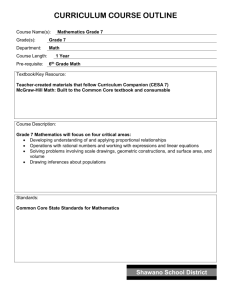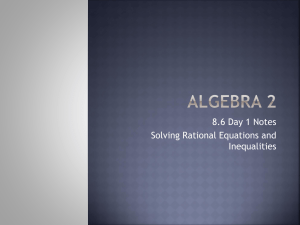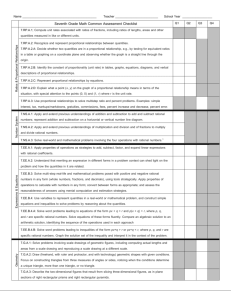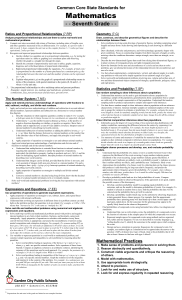GENERIC EVALUATION CRITERIA
advertisement
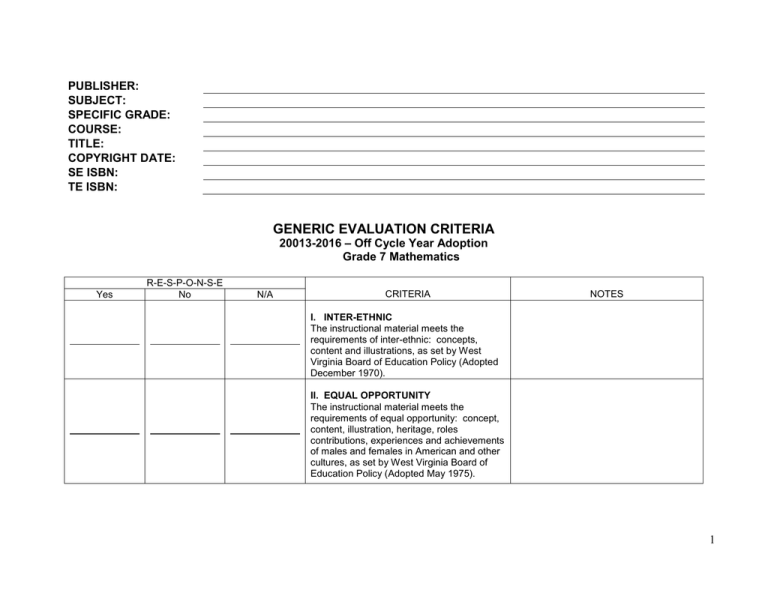
PUBLISHER: SUBJECT: SPECIFIC GRADE: COURSE: TITLE: COPYRIGHT DATE: SE ISBN: TE ISBN: GENERIC EVALUATION CRITERIA 20013-2016 – Off Cycle Year Adoption Grade 7 Mathematics Yes R-E-S-P-O-N-S-E No N/A CRITERIA NOTES I. INTER-ETHNIC The instructional material meets the requirements of inter-ethnic: concepts, content and illustrations, as set by West Virginia Board of Education Policy (Adopted December 1970). II. EQUAL OPPORTUNITY The instructional material meets the requirements of equal opportunity: concept, content, illustration, heritage, roles contributions, experiences and achievements of males and females in American and other cultures, as set by West Virginia Board of Education Policy (Adopted May 1975). 1 III. FORMAT The resource is available as an option for adoption in an interactive electronic format. INSTRUCTIONAL MATERIALS ADOPTION: 21st CENTURY LEARNING EVALUATION CRITERIA GENERAL EVALUATION CRITERIA 20013-2016 – Off Cycle Year Adoption Grade 7 Mathematics INSTRUCTIONAL MATERIALS ADOPTION: GENERAL EVALUATION CRITERIA The general evaluation criteria apply to each grade level and are to be evaluated for each grade level unless otherwise specified. These criteria consist of information critical to the development of all grade levels. In reading the general evaluation criteria and subsequent specific grade level criteria, e.g. means “examples of” and i.e. means that “each of” those items must be addressed. Eighty percent of the general criteria must be met with I (In-depth) or A (Adequate) in order to be recommended. 2 (Vendor/Publisher) SPECIFIC LOCATION OF CONTENT WITHIN PRODUCT (IMR Committee) Responses I=In-depth A=Adequate M=Minimal N=Nonexistent I A M N For student mastery of content standards and objectives, the instructional materials will provide students with the opportunity to apply: A. MATHEMATICAL PRACTICES 1. Make sense of problems and persevere in solving them. Explain to themselves the meaning of a problem and looking for entry points to its solution. Analyze givens, constraints, relationships, and goals Make conjectures about the form and meaning of the solution attempt. Plan a solution pathway rather than simply jumping into a solution. Consider analogous problems and try special cases and simpler forms of insight into its solution. Monitor and evaluate their progress and change course if necessary. Transform algebraic expressions or change the viewing window on their graphing calculator to get information. Explain correspondences between equations, verbal descriptions, tables, and graphs. Draw diagrams of important features and relationships, graph data, and search for regularity or trends. Use concrete objects or pictures to help conceptualize and solve a problem. Check their answers to problems using a different method. Ask themselves, “Does this make sense?” Understand the approaches of others to solving complex 3 problems and identify correspondences between approaches. 2. Reason abstractly and quantitatively. Make sense of quantities and their relationships in problem situations. Bring two complementary abilities to bear on problems involving quantitative relationships: o Decontextualize (abstract a given situation and represent it symbolically and manipulate the representing symbols as if they have a life of their own, without necessarily attending to their referents and o Contextualize (pause as needed during the manipulation process in order to probe into the referents for the symbols involved). Use quantitative reasoning that entails creating a coherent representation of the problem at hand, considering the units involved, and attending to the meaning of quantities, not just how to compute them Know and flexibly use different properties of operations and objects. 3. Construct viable arguments and critique the reasoning of others. Understand and use stated assumptions, definitions, and previously established results in constructing arguments. Make conjectures and build a logical progression of statements to explore the truth of their conjectures. Analyze situations by breaking them into cases Recognize and use counterexamples. Justify their conclusions, communicate them to others, and respond to the arguments of others. Reason inductively about data, making plausible arguments that take into account the context from which the data arose. Compare the effectiveness of plausible arguments. Distinguish correct logic or reasoning from that which is flawed 4 and, if there is a flaw, explain what it is o Elementary students construct arguments using concrete referents such as objects, drawings, diagrams, and actions. o Later students learn to determine domains to which an argument applies. Listen or read the arguments of others, decide whether they make sense, and ask useful question to clarify or improve arguments. 4. Model with mathematics. Apply the mathematics they know to solve problems arising in everyday life, society, and the workplace. o In early grades, this might be as simple as writing an addition equation to describe a situation. In middle grades, a student might apply proportional reasoning to plan a school event or analyze a problem in the community. o By high school, a student might use geometry to solve a design problem or use a function to describe how one quantity of interest depends on another. Make assumptions and approximations to simplify a complicated situation, realizing that these may need revision later. Identify important quantities in a practical situation Map their relationships using such tools as diagrams, two-way tables, graphs, flowcharts and formulas. Analyze those relationships mathematically to draw conclusions. Interpret their mathematical results in the context of the situation. Reflect on whether the results make sense, possibly improving the model if it has not served its purpose. 5. Use appropriate tools strategically. Consider available tools when solving a mathematical problem. (these tools might include pencil and paper, concrete models, a ruler, protractor, calculator, spreadsheet, computer algebra system, a statistical package, or dynamic geometry software. 5 Are sufficiently familiar with tools appropriate for their grade or course to make sound decisions about when each of these tools might be helpful, recognizing both the insight to be gained and their limitations. o High school students analyze graphs of functions and solutions generated using a graphing calculator Detect possible errors by using estimations and other mathematical knowledge. Know that technology can enable them to visualize the results of varying assumptions, explore consequences, and compare predictions with data. Identify relevant mathematical resources and use them to pose or solve problems. Use technological tools to explore and deepen their understanding of concepts. 6. Attend to precision. Try to communicate precisely to others. Try to use clear definitions in discussion with others and in their own reasoning. State the meaning of the symbols they choose, including using the equal sign consistently and appropriately. Specify units of measure and label axes to clarify the correspondence with quantities in a problem. Calculate accurately and efficiently, express numerical answers with a degree of precision appropriate for the problem context. o In the elementary grades, students give carefully formulated explanations to each other. o In high school, students have learned to examine claims and make explicit use of definitions. 7. Look for and make use of structure. Look closely to discern a pattern or structure. o Young students might notice that three and seven more is the same amount as seven and three more or they may sort a 6 collection of shapes according to how many sides the shapes have. o Later, students will see 7 x 8 equals the well remembered 7 x 5 + 7 x 3, in preparation for the distributive property. o In the expression x2 + 9x + 14, older students can see the 14 as 2 x 7 and the 9 as 2 + 7. They recognize the significance of an existing line in a geometric figure and can use the strategy of drawing an auxiliary line for solving problems. Step back for an overview and can shift perspective. See complicated things, such as some algebraic expressions, as single objects or composed of several objects. 8. Look for and express regularity in repeated reasoning. Notice if calculations are repeated. Look both for general methods and for shortcuts. o Upper elementary students might notice when dividing 25 by 11 that they are repeating the same calculations over and over again, and conclude they have a repeated decimal. o Middle school students might abstract the equation (y-2)/((x-1)=3 by paying attention to the calculation of slope as they repeatedly check whether the points are on the line through (1,2) with a slope 3. o Noticing the regularity in the way terms cancel when expanding (x-1)(x+1)(x2+1) and (x-1)(x3+x2+x+1) might lead high school students to the general formula for the sum of a geometric series. Maintain oversight of the process of solving a problem, while attending to the details. Continually evaluate the reasonableness of intermediate results. 7 SPECIFIC EVALUATION CRITERIA 20013-2016 – Off Cycle Year Adoption Grade 7 Mathematics In Grade 7, instructional time should focus on four critical areas: (1) developing understanding of and applying proportional relationships; (2) developing understanding of operations with rational numbers and working with expressions and linear equations; (3) solving problems involving scale drawings and informal geometric constructions and working with twoand three-dimensional shapes to solve problems involving area, surface area and volume; and (4) drawing inferences about populations based on samples. 1. Students extend their understanding of ratios and develop understanding of proportionality to solve single- and multi-step problems. Students use their understanding of ratios and proportionality to solve a wide variety of percent problems, including those involving discounts, interest, taxes, tips and percent increase or decrease. Students solve problems about scale drawings by relating corresponding lengths between the objects or by using the fact that relationships of lengths within an object are preserved in similar objects. Students graph proportional relationships and understand the unit rate informally as a measure of the steepness of the related line, called the slope. They distinguish proportional relationships from other relationships. 2. Students develop a unified understanding of number, recognizing fractions, decimals (that have a finite or a repeating decimal representation), and percents as different representations of rational numbers. Students extend addition, subtraction, multiplication and division to all rational numbers, maintaining the properties of operations and the relationships between addition and subtraction and multiplication and division. By applying these properties and by viewing negative numbers in terms of everyday contexts (e.g., amounts owed or temperatures below zero), students explain and interpret the rules for adding, subtracting, multiplying and dividing with negative numbers. They use the arithmetic of rational numbers as they formulate expressions and equations in one variable and use these equations to solve problems. 3. Students continue their work with area from Grade 6, solving problems involving the area and circumference of a circle and surface area of three-dimensional objects. In preparation for work on congruence and similarity in Grade 8 they reason about relationships among two-dimensional figures using scale drawings and informal geometric constructions, and they gain familiarity with the relationships between angles formed by intersecting lines. Students work with three-dimensional figures, relating them to twodimensional figures by examining cross-sections. They solve real-world and mathematical problems involving area, surface area and volume of two- and three-dimensional objects composed of triangles, quadrilaterals, polygons, cubes and right prisms. 4. Students build on their previous work with single data distributions to compare two data distributions and address questions about differences between populations. They begin informal work with random sampling to generate data sets and learn about the importance of representative samples for drawing inferences. of a right rectangular prism to fractional side lengths. They prepare for work on scale drawings and constructions in Grade 7 by drawing polygons in the coordinate plane. 8 (IMR Committee) Responses (Vendor/Publisher) SPECIFIC LOCATION OF CONTENT WITHIN PRODUCT I=In-depth A=Adequate M=Mi nimal N=Nonexistent I A M N For student mastery of content standards and objectives, the instructional materials will provide students with the opportunity to A. Ratios & Proportional Relationships Analyze proportional relationships and use them to solve real-world and mathematical problems. 1. compute unit rates associated with ratios of fractions, including ratios of lengths, areas and other quantities measured in like or different units. For example, if a person walks 1/2 mile in each 1/4 hour, compute the unit rate as the complex fraction 1/2/1/4 miles per hour, equivalently 2 miles per hour. 2. recognize and represent proportional relationships between quantities. a. Decide whether two quantities are in a proportional relationship, e.g., by testing for equivalent ratios in a table or graphing on a coordinate plane and observing whether the graph is a straight line through the origin. b. Identify the constant of proportionality (unit rate) in tables, graphs, equations, diagrams and verbal descriptions of proportional relationships. c. Represent proportional relationships by equations. For example, if total cost t is proportional to the number n of items purchased at a constant price p, the relationship between the total cost and the number of items can be expressed as t = pn. d. Explain what a point(x, y) on the graph of a proportional relationship means in terms of the situation, with special 9 attention to the points (0,0) and (1,r ) where r is the unit rate. 3. use proportional relationships to solve multistep ratio and percent problems. Examples: simple interest, tax, markups and markdowns, gratuities and commissions, fees, percent increase and decrease, percent error. B. The Number System Apply and extend previous understandings of operations with fractions to add, subtract, multiply, and divide rational numbers. 1. apply and extend previous understandings of addition and subtraction to add and subtract rational numbers; represent addition and subtraction on a horizontal or vertical number line diagram. a. Describe situations in which opposite quantities combine to make 0. For example, a hydrogen atom has 0 charge because its two constituents are oppositely charged. b. Understand p + q as the number located a distance |q| from p, in the positive or negative direction depending on whether q is positive or negative. Show that a number and its opposite have a sum of 0 (are additive inverses). Interpret sums of rational numbers by describing real-world contexts. c. Understand subtraction of rational numbers as adding the additive inverse, p – q = p + (–q). Show that the distance between two rational numbers on the number line is the absolute value of their difference and apply this principle in real-world contexts. d. Apply properties of operations as strategies to add and subtract rational numbers. 2. apply and extend previous understandings of multiplication and division and of fractions to multiply and divide rational numbers. a. Understand that multiplication is extended from fractions to rational numbers by requiring that operations continue to 10 satisfy the properties of operations, particularly the distributive property, leading to products such as (–1)(–1) = 1 and the rules for multiplying signed numbers. Interpret products of rational numbers by describing real-world contexts. b. Understand that integers can be divided, provided that the divisor is not zero, and every quotient of integers (with nonzero divisor) is a rational number. If p and q are integers, then –(p/q) = (–p)/q = p/(–q). Interpret quotients of rational numbers by describing real world contexts. c. Apply properties of operations as strategies to multiply and divide rational numbers. d. Convert a rational number to a decimal using long division; know that the decimal form of a rational number terminates in 0s or eventually repeats. 3. solve real-world and mathematical problems involving the four operations with rational numbers. (Computations with rational numbers extend the rules for manipulating fractions to complex fractions.) C. Expressions & Equations Use properties of operations to generate equivalent expressions. 1. apply properties of operations as strategies to add, subtract, factor and expand linear expressions with rational coefficients. 2. understand that rewriting an expression in different forms in a problem context can shed light on the problem and how the quantities in it are related. For example, a + 0.05a = 1.05a means that “increase by 5%” is the same as “multiply by 1.05.” 11 Solve real-life and mathematical problems using numerical and algebraic expressions and equations. 3. solve multi-step real-life and mathematical problems posed with positive and negative rational numbers in any form (whole numbers, fractions, and decimals), using tools strategically. Apply properties of operations to calculate with numbers in any form; convert between forms as appropriate; and assess the reasonableness of answers using mental computation and estimation strategies. For example: If a woman making $25 an hour gets a 10% raise, she will make an additional 1/10 of her salary an hour, or $2.50, for a new salary of $27.50. If you want to place a towel bar 9 3/4 inches long in the center of a door that is 27 1/2 inches wide, you will need to place the bar about 9 inches from each edge; this estimate can be used as a check on the exact computation. 4. use variables to represent quantities in a real-world or mathematical problem and construct simple equations and inequalities to solve problems by reasoning about the quantities. a. Solve word problems leading to equations of the form px + q = r and p(x + q) = r, where p, q, and r are specific rational numbers. Solve equations of these forms fluently. Compare an algebraic solution to an arithmetic solution, identifying the sequence of the operations used in each approach. For example, the perimeter of a rectangle is 54 cm. Its length is 6 cm. What is its width? b. Solve word problems leading to inequalities of the form px + q > r or px + q < r, where p, q, and r are specific rational numbers. Graph the solution set of the inequality and interpret it in the context of the problem. For example: As a salesperson, you are paid $50 per week plus $3 per sale. This week you want your pay to be at least $100. Write an inequality for the number of sales you need to make, and describe the solutions. 12 D. Geometry Draw, construct and describe geometrical figures and describe the relationships between them. 1. solve problems involving scale drawings of geometric figures, including computing actual lengths and areas from a scale drawing and reproducing a scale drawing at a different scale. 2. draw (freehand, with ruler and protractor, and with technology) geometric shapes with given conditions. Focus on constructing triangles from three measures of angles or sides, noticing when the conditions determine a unique triangle, more than one triangle, or no triangle. 3. describe the two-dimensional figures that result from slicing threedimensional figures, as in plane sections of right rectangular prisms and right rectangular pyramids. Solve real-life and mathematical problems involving angle measure, area, surface area, and volume. 4. know the formulas for the area and circumference of a circle and use them to solve problems; give an informal derivation of the relationship between the circumference and area of a circle. 5. use facts about supplementary, complementary, vertical, and adjacent angles in a multi-step problem to write and solve simple equations for an unknown angle in a figure. 6. solve real-world and mathematical problems involving area, volume and surface area of two- and three-dimensional objects composed of triangles, quadrilaterals, polygons, cubes, and right prisms. E. Statistics & Probability 13 Use random sampling to draw inferences about a population. 1. understand that statistics can be used to gain information about a population by examining a sample of the population; generalizations about a population from a sample are valid only if the sample is representative of that population. Understand that random sampling tends to produce representative samples and support valid inferences. 2. understand that a set of data collected to answer a statistical question has a distribution which can be described by its center, spread, and overall shape. use data from a random sample to draw inferences about a population with an unknown characteristic of interest. Generate multiple samples (or simulated samples) of the same size to gauge the variation in estimates or predictions. For example, estimate the mean word length in a book by randomly sampling words from the book; predict the winner of a school election based on randomly sampled survey data. Gauge how far off the estimate or prediction might be. Draw informal comparative inferences about two populations. 3. informally assess the degree of visual overlap of two numerical data distributions with similar variabilities, measuring the difference between the centers by expressing it as a multiple of a measure of variability. For example, the mean height of players on the basketball team is 10 cm greater than the mean height of players on the soccer team, about twice the variability (mean absolute deviation) on either team; on a dot plot, the separation between the two distributions of heights is noticeable. 4. use measures of center and measures of variability for numerical data from random samples to draw informal comparative inferences about two populations. For example, decide whether the words in a chapter 14 of a seventh-grade science book are generally longer than the words in a chapter of a fourth-grade science book. Investigate chance processes and develop, use, and evaluate probability models. 5. understand that the probability of a chance event is a number between 0 and 1 that expresses the likelihood of the event occurring. Larger numbers indicate greater likelihood. A probability near 0 indicates an unlikely event, a probability around 1/2 indicates an event that is neither unlikely nor likely and a probability near 1 indicates a likely event. 6. approximate the probability of a chance event by collecting data on the chance process that produces it and observing its long-run relative frequency, and predict the approximate relative frequency given the probability. For example, when rolling a number cube 600 times, predict that a 3 or 6 would be rolled roughly 200 times, but probably not exactly 200 times. 7. develop a probability model and use it to find probabilities of events. Compare probabilities from a model to observed frequencies; if the agreement is not good, explain possible sources of the discrepancy. a. Develop a uniform probability model by assigning equal probability to all outcomes, and use the model to determine probabilities of events. For example, if a student is selected at random from a class, find the probability that Jane will be selected and the probability that a girl will be selected. b. Develop a probability model (which may not be uniform) by observing frequencies in data generated from a chance process. For example, find the approximate probability that a spinning penny will land heads up or that a tossed paper cup will land open-end down. Do the outcomes for the spinning penny appear to be equally likely based on the observed frequencies? 15 8. find probabilities of compound events using organized lists, tables, tree diagrams, and simulation. a. Understand that, just as with simple events, the probability of a compound event is the fraction of outcomes in the sample space for which the compound event occurs. b. Represent sample spaces for compound events using methods such as organized lists, tables and tree diagrams. For an event described in everyday language (e.g., “rolling double sixes”), identify the outcomes in the sample space which compose the event. c. Design and use a simulation to generate frequencies for compound events. For example, use random digits as a simulation tool to approximate the answer to the question: If 40% of donors have type A blood, what is the probability that it will take at least 4 donors to find one with type A blood? 16

